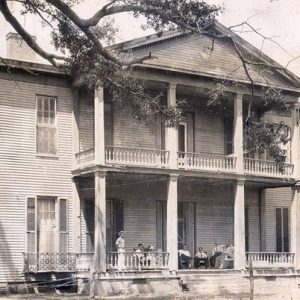calsfoundation@cals.org
Lycurgus Leonidas Johnson (1818–1876)
Lycurgus Leonidas Johnson was one of the largest cotton planters and slaveowners in antebellum Arkansas. Around 1860, he built an imposing, seventeen-room mansion in the Greek Revival style along the banks of the Mississippi River at his Lakeport Plantation in Chicot County.
Lycurgus Johnson was born on March 22, 1818, the eldest of nine children born to Joel Johnson and Verlinda Offutt Johnson of Scott County, Kentucky. The Johnsons were among the most prominent families in early Kentucky. Johnson’s paternal grandfather, Robert Johnson, was a political, educational, and religious leader in the Bluegrass State; he had been instrumental in establishing Transylvania Seminary (later Transylvania University) at Lexington, the Rittenhouse Academy in Scott County, and the Kentucky Society for Promoting Useful Knowledge. One of Lycurgus’s uncles, Richard Mentor Johnson, served as vice president under Martin Van Buren. Another uncle, Benjamin Johnson, became a distinguished Arkansas jurist and a leading figure in the state’s Democratic political dynasty known as “The Family.”
Johnson’s father, Joel, came to Chicot County in the southeastern-most reaches of the Arkansas Delta in 1831 and established a plantation called Lakeport along the Mississippi River. Within fifteen years, Lakeport was one of the most prosperous cotton-growing operations in the Delta, and Johnson became one of the wealthiest and most influential men in the state. Like many early planters, he spent only part of the year in Arkansas, returning to his family in Kentucky for about half the year.
Sometime in the late 1830s, while he was still in his teens, Lycurgus Johnson left the family home in Kentucky to join his father in Arkansas. He established his own plantation in Chicot County, downriver from Lakeport. On January 12, 1842, he married Lydia Taylor, and the couple had eleven children, six of whom lived to adulthood.
A lengthy legal battle prevented the Johnson heirs from establishing a clear title to Lakeport after the death of Joel Johnson in June 1846. Finally, in 1857, a favorable court decision allowed Lycurgus to gain control of the plantation and consolidate it into his holdings. By 1860, he owned more than 4,000 acres of rich Delta land and 150 slaves and produced some 1,300 bales of cotton and 10,000 bushels of corn. The total value of his taxable property exceeded $200,000.
To crown his plantation, Johnson constructed an imposing mansion. It was an L-shaped structure measuring sixty-six feet long by forty-four feet wide. The front of the house had a two-story portico with a triangular pediment gable and centered rose windows. With its tapered columns and wrought-iron, lacework grill in an oak leaf and acorn design, the Lakeport plantation house was a showplace of the state’s cotton aristocracy.
The Civil War caused a dramatic decline in Johnson’s fortunes, as it did for most Delta planters. Chicot County was the scene of heavy fighting and suffered great physical devastation. However, Johnson retained control of his house and land, adjusted to the new realities of the postwar South, and began to rebuild his Lakeport operation, utilizing the labor of many of the same men and women who had formerly been slaves on the plantation. By 1870, he was the leading cotton producer in the county.
Johnson’s conduct during this difficult period demonstrated the qualities that had earned him the admiration and respect of his neighbors in the years before the war. The local agent of the Freedmen’s Bureau, a man not favorably disposed to planters, remarked that Johnson “works one hundred hands and does them the fullest justice” and referred to him as a “model man of Chicot County.”
In May 1874, Johnson was elected to represent Chicot County in the state legislature. Appointed to the Committee on Agriculture and the Committee on Cities and Towns, he sponsored bills to remit the penalty for the nonpayment of taxes in Chicot County and to empower aliens to acquire real estate. The latter measure laid the groundwork for the importation of Italian immigrant workers into Chicot County in the 1890s. Aside from his time as a legislator, Johnson apparently lived out the turbulent Reconstruction years in the peaceful surroundings at Lakeport. A chronicler of the county referred to him as “a good citizen and able business man” and “a gentleman of superior education… noted for hospitality, dignity and social culture.”
In his fifty-eighth year, Johnson suffered from a severe gastrointestinal disorder that eventually took his life. He died on August 1, 1876, in Wilmington, Delaware, where he had gone for medical treatment.
For additional information:
Biographical and Historical Memoirs of Southern Arkansas. Chicago: Goodspeed Publishing Company, 1890.
DeBlack, Thomas A. “A Garden in the Wilderness: The Johnsons and the Making of Lakeport Plantation, 1831–1876.” Ph.D. diss., University of Arkansas at Fayetteville, 1995.
Thomas A. DeBlack
Arkansas Tech University
This entry, originally published in Arkansas Biography: A Collection of Notable Lives, appears in the CALS Encyclopedia of Arkansas in an altered form. Arkansas Biography is available from the University of Arkansas Press.
 Business, Commerce, and Industry
Business, Commerce, and Industry Louisiana Purchase through Early Statehood, 1803 through 1860
Louisiana Purchase through Early Statehood, 1803 through 1860 Politics and Government
Politics and Government Lakeport Plantation
Lakeport Plantation  Lakeport Plantation
Lakeport Plantation 




Comments
No comments on this entry yet.